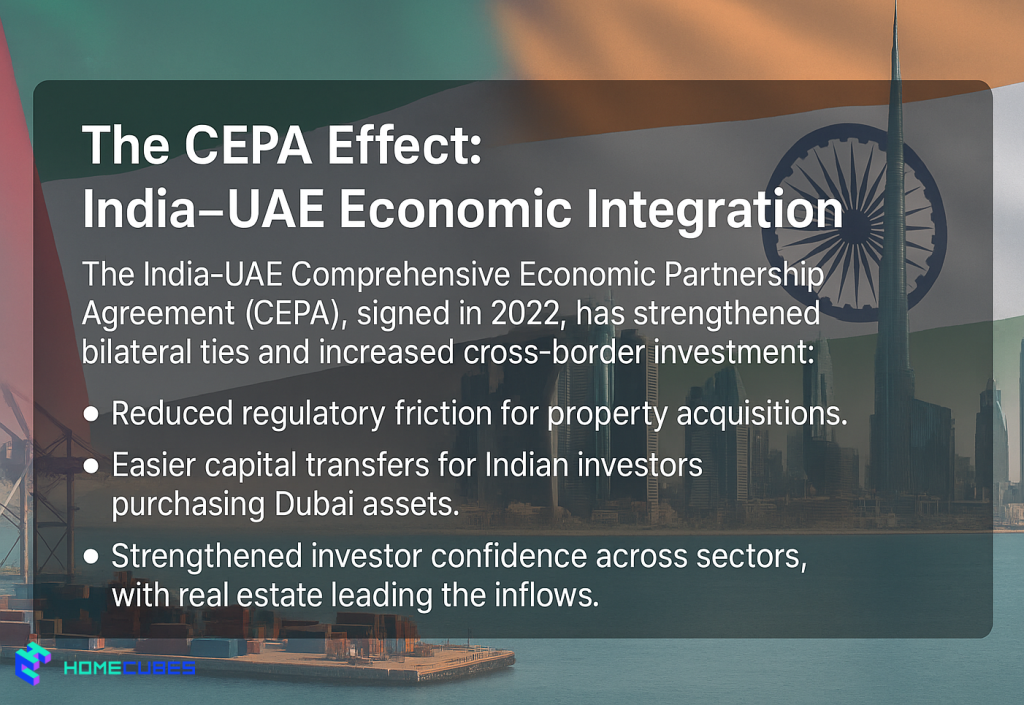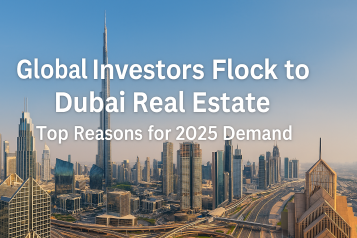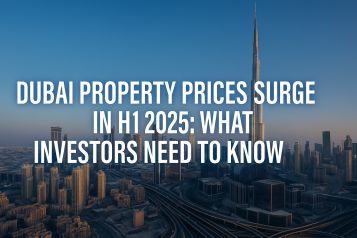

Introduction
Dubai’s property market has entered a golden era in 2025, fueled by record-breaking sales, high rental yields, investor-friendly policies, and an aspirational lifestyle offering unmatched by regional peers. Among the most active participants in this growth story are Indian investors, who continue to dominate foreign property transactions, reshaping Dubai’s residential and luxury landscapes.
From tax-free wealth creation to 10-year Golden Visas and fractional ownership opportunities, Dubai offers Indian investors the perfect blend of returns, security, and lifestyle appeal and makes investors thrive in the Dubai property market. Let’s explore the data, trends, and opportunities that make Dubai the top choice for Indian property buyers in 2025.
What’s India’s potential?
Well, Singapore previewed what China could look like.
And Dubai may preview what India could look like.
Because Indians are 38% of Dubai’s population.
While South Asians are >50%.
And by working with Emiratis…
They built a city that looks like this: pic.twitter.com/8FgVWtpr3h— Balaji (@balajis) June 25, 2025
Dubai’s Property Market Surge in 2025
Dubai’s real estate sector continues its upward momentum, breaking historical benchmarks:
- AED 210 billion in transactions across 67,000 property deals in H1 2025, marking a 20% year-on-year growth.
- Super-prime properties above USD 10 million recorded 111 sales worth USD 1.9 billion in Q1 and USD 2.6 billion in Q2 — making Dubai the world leader in luxury real estate deals.
- Total 2024 residential sales crossed 170,000 transactions worth USD 100 billion, with AED 100 billion achieved by March 2025 alone (Knight Frank 2025 Report).
This surge in Dubai property price in H1 2025, isn’t limited to high-end properties; off-plan projects dominate sales, accounting for nearly 70% of Q1 2025 transactions, highlighting investor confidence in Dubai’s long-term growth story.
Why Indian Investors Lead the Charge

Indian nationals consistently rank among the top foreign property buyers in Dubai and, in 2024, contributed over AED 35 billion (~USD 9.5 billion) to Dubai’s real estate market. This represented 22% of all foreign property transactions, underscoring the deep integration between India’s high-net-worth investors and Dubai’s property ecosystem (DLD via Aeon Trisl).
Several factors drive this dominance:
- Proximity: A short 3-hour flight connects major Indian metros with Dubai.
- Residency benefits: 10-year Golden Visa eligibility at AED 2 million property investment thresholds.
- Demographics: The UAE hosts nearly 4 million Indians, including 2 million in Dubai, forming a natural demand base (Indian diaspora data).
- Diversification: Indian investors seek to hedge against domestic market volatility by tapping Dubai’s high-growth, tax-free ecosystem.
Tax-Free Wealth Creation
For Indian investors, Dubai’s tax advantages represent a significant draw:
- No capital gains tax on property sales.
- No annual property taxes or recurring wealth taxes.
- No inheritance tax, ensuring smoother cross-generational asset transfers.
Compared to India — where combined taxes on property gains can exceed 20% — Dubai offers a highly efficient structure for wealth preservation and portfolio diversification.
High Rental Yields & ROI Potential
Dubai remains one of the most lucrative real estate markets globally for rental income:
- Residential apartments: Average yields between 5% and 7%.
- Leasehold properties: Returns of 7.5% to 8% in sought-after communities.
- Villas and townhouses: Average yields around 4.5% to 6%.
By contrast, Indian metros like Mumbai, Delhi, and Bangalore typically deliver 2% to 3% yields, making Dubai an attractive choice for investors prioritizing cash flow and total ROI.
Golden Visa: Gateway to Long-Term Residency
The UAE’s Golden Visa program has transformed Dubai into a preferred investment destination for Indian buyers:
- Minimum property investment of AED 2 million (~USD 545,000) grants 10-year renewable residency.
- Investors can sponsor spouses, children, and domestic staff.
- Residency validity is maintained even if you live outside the UAE for extended periods.
Golden Visa reforms in 2025 have streamlined the process — approvals can now be secured within 7–10 working days once the property title deed is registered.
Top Communities Preferred by Indian Investors
Indian buyers favor vibrant communities that balance luxury, lifestyle, and rental potential. The most sought-after neighborhoods in 2025 include:
- Jumeirah Village Circle (JVC): Affordable off-plan properties with high demand and rental yields of 7%–8%.
- Business Bay: Premium apartments attracting professionals and offering 6% average yields.
- Downtown Dubai: Home to the Burj Khalifa, perfect for luxury-driven investors seeking capital appreciation.
- Palm Jumeirah: A global icon for ultra-prime beachfront living with consistent resale value.
- Dubai Creek Harbour: An emerging hotspot for eco-conscious investors focused on sustainable, waterfront living.
The CEPA Effect: India-UAE Economic Integration
The India-UAE Comprehensive Economic Partnership Agreement (CEPA), signed in 2022, has strengthened bilateral ties and increased cross-border investment:

- Reduced regulatory friction for property acquisitions.
- Easier capital transfers for Indian investors purchasing Dubai assets.
- Strengthened investor confidence across sectors, with real estate leading the inflows.
With CEPA acting as a catalyst, Indian property transactions in Dubai are projected to cross AED 40 billion in 2025.
Fractional Ownership & Tokenized Real Estate
Dubai is at the forefront of real estate innovation through fractional ownership models and property tokenization:
- Indian investors can now buy shares of premium properties, lowering entry barriers.
- Tokenized platforms enable secure, transparent ownership via blockchain-backed records.
- Regulatory frameworks under Dubai Land Department ensure investor protection while opening doors for smaller-ticket participation.
Case Study: Indian Investment Trends (2018 → 2025)
| Year | Estimated Indian Investment | Key Drivers |
| 2018–2019 | AED 10B | Early adoption among HNWIs, limited regulatory reforms. |
| 2020–2021 | AED 15B | Pandemic-driven relocation trends; lifestyle investments. |
| 2022 | AED 20B | CEPA signed → accelerated cross-border capital flows. |
| 2023–2024 | AED 35B | Golden Visa reforms + off-plan boom + attractive yields. |
| 2025 (Projected) | AED 40B+ | Tokenization, super-prime surge, population growth. |
Fees and Charges Indian Investors Should Know
Before committing to a Dubai property, it’s essential to budget for associated costs:
- Dubai Land Department (DLD) fee: 4% of the property value.
- Registration fees: Varies depending on purchase price.
- Agency commissions: Typically 2% of property value.
- Service charges: Average AED 15–30 per sq. ft annually, depending on the community.
- Golden Visa processing fee: Approximately AED 3,000–AED 5,000.
Mistakes Indian Investors Should Avoid in 2025
- Overpaying in speculative zones: Focus on researched, high-demand communities.
- Ignoring supply dynamics: Dubai plans to deliver 73,000+ new units in 2025, which could affect oversupply risk in some areas.
- Underestimating currency fluctuations: AED-INR volatility can impact net ROI.
- Skipping legal due diligence: Always verify RERA registration and project escrow compliance.
Risks and Challenges
While Dubai’s property market remains robust, investors should stay aware of potential risks:
- Oversupply in certain micro-markets due to aggressive development pipelines.
- Global macroeconomic headwinds, including rising interest rates.
- Premium pricing pressures in super-prime segments like Palm Jumeirah and Downtown.
Mitigating these risks requires careful selection, reliable advisors, and leveraging Dubai’s transparent regulatory frameworks.
Future Outlook: Dubai Real Estate 2033 and Beyond
Dubai’s Real Estate Strategy 2033 aims to position the city as a global investment powerhouse:
- Expansion of housing supply to 300,000+ units by 2028.
- Focus on smart cities, sustainability, and green mortgages.
- Integration of blockchain-based ownership and digital twins for real estate asset management.
For Indian investors, this translates to long-term capital growth, robust rental streams, and continued innovation in ownership models.
FAQs
What is the minimum investment for a 10-year Golden Visa?
AED 2 million (~USD 545,000), with processing timelines reduced to 7–10 working days.
Which areas are most popular among Indian investors in 2025?
JVC, Business Bay, Downtown Dubai, Palm Jumeirah, and Dubai Creek Harbour.
What’s the average rental yield in Dubai?
Yields average 6%–7%, nearly double those in India’s leading metros.
Can Indian investors buy freehold property in Dubai?
Yes, in designated freehold zones, offering full ownership rights.
Is fractional property ownership legal in Dubai?
Yes, tokenized and fractional ownership models are regulated under DLD frameworks.
Unlock Dubai’s Investment Potential
Dubai’s real estate market in 2025 presents unmatched opportunities for Indian investors seeking high-yield, tax-efficient, and globally connected assets. While traditional property ownership remains popular, fractional ownership and real estate tokenization are shaping the future of investments — lowering entry barriers while enabling access to premium developments.
At Homecubes, we are preparing to become one of Dubai’s most innovative fractional property investment platforms, focused on enabling seamless, compliant, and investor-friendly participation in Dubai’s real estate market.
Our VARA license application is currently under process, and once approved, Homecubes will empower Indian investors to:
- Access high-value Dubai properties via fractional ownership
- Participate in tokenized real estate under VARA regulatory compliance
- Diversify portfolios with reduced capital thresholds and maximized ROI potential
We’re building a platform designed to make Dubai property investment simpler, smarter, and more transparent.
Be among the first to know when Homecubes launches — connect with us today and secure your place in Dubai’s next wave of fractional ownership opportunities.










